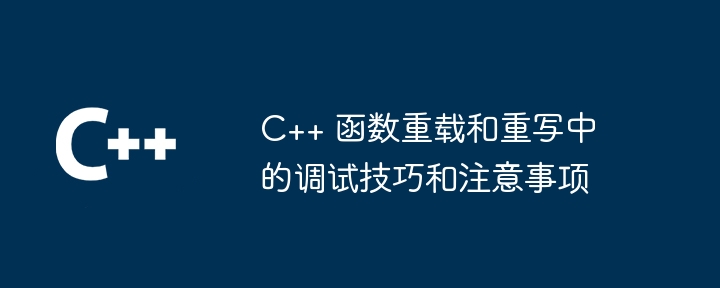
For debugging in C function overloading and rewriting, key issues include: Debugging overloading: Use qualifiers to explicitly specify the overloaded function to be called, and use debug output to verify overload correctness. Debug overrides: Verify inheritance, ensure signatures match, add debug output, and disable base class methods using the override keyword to force type checking.

Debugging tips and considerations in C function overloading and rewriting
Key concepts
Debug overloading
Example
// 定义重载函数
double max(int a, int b);
double max(double a, double b);
int main() {
// 调用重载函数
double d1 = max(10, 15);
double d2 = max(12.5, 10.3);
// 使用输出验证重载
std::cout << "d1: " << d1 << std::endl;
std::cout << "d2: " << d2 << std::endl;
return 0;
}Debug override
Practical case
Imagine the following scenario:
Shape, contains the draw() method for drawing shapes. Circle, inheriting from Shape, and override the draw() method to draw a circle. But when Circle::draw() is called, it draws a square (the behavior of the base class Shape)!
Debugging steps:
Circle class correctly inherits from Shape . Circle::draw() and Shape::draw() methods to make sure they match exactly. Circle::draw() method to verify that it is being called. Fix suggestions:
If the signatures match and the inheritance is correct, then this can be fixed by:
override keyword in a subclass method declaration to indicate that it overrides the base class method. This will force type checking at compile time. Note:
The above is the detailed content of Debugging tips and considerations in C++ function overloading and rewriting. For more information, please follow other related articles on the PHP Chinese website!
 What are the differences between c++ and c language
What are the differences between c++ and c language
 Recommended learning order for c++ and python
Recommended learning order for c++ and python
 Cost-effectiveness analysis of learning python and c++
Cost-effectiveness analysis of learning python and c++
 Is c language the same as c++?
Is c language the same as c++?
 Which is better to learn first, c language or c++?
Which is better to learn first, c language or c++?
 The difference and connection between c language and c++
The difference and connection between c language and c++
 C++ software Chinese change tutorial
C++ software Chinese change tutorial
 Cost-effectiveness analysis of learning python, java and c++
Cost-effectiveness analysis of learning python, java and c++




